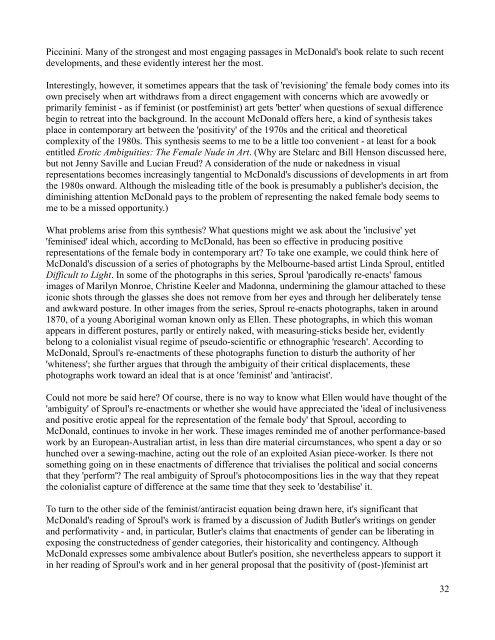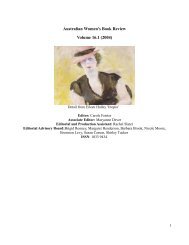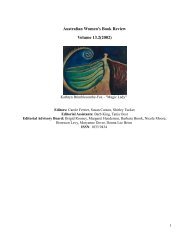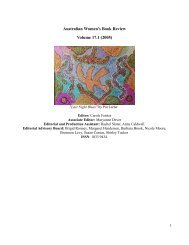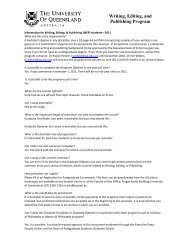Australian Women's Book Review Volume 14.1 - School of English ...
Australian Women's Book Review Volume 14.1 - School of English ...
Australian Women's Book Review Volume 14.1 - School of English ...
Create successful ePaper yourself
Turn your PDF publications into a flip-book with our unique Google optimized e-Paper software.
Piccinini. Many <strong>of</strong> the strongest and most engaging passages in McDonald's book relate to such recent<br />
developments, and these evidently interest her the most.<br />
Interestingly, however, it sometimes appears that the task <strong>of</strong> 'revisioning' the female body comes into its<br />
own precisely when art withdraws from a direct engagement with concerns which are avowedly or<br />
primarily feminist - as if feminist (or postfeminist) art gets 'better' when questions <strong>of</strong> sexual difference<br />
begin to retreat into the background. In the account McDonald <strong>of</strong>fers here, a kind <strong>of</strong> synthesis takes<br />
place in contemporary art between the 'positivity' <strong>of</strong> the 1970s and the critical and theoretical<br />
complexity <strong>of</strong> the 1980s. This synthesis seems to me to be a little too convenient - at least for a book<br />
entitled Erotic Ambiguities: The Female Nude in Art. (Why are Stelarc and Bill Henson discussed here,<br />
but not Jenny Saville and Lucian Freud? A consideration <strong>of</strong> the nude or nakedness in visual<br />
representations becomes increasingly tangential to McDonald's discussions <strong>of</strong> developments in art from<br />
the 1980s onward. Although the misleading title <strong>of</strong> the book is presumably a publisher's decision, the<br />
diminishing attention McDonald pays to the problem <strong>of</strong> representing the naked female body seems to<br />
me to be a missed opportunity.)<br />
What problems arise from this synthesis? What questions might we ask about the 'inclusive' yet<br />
'feminised' ideal which, according to McDonald, has been so effective in producing positive<br />
representations <strong>of</strong> the female body in contemporary art? To take one example, we could think here <strong>of</strong><br />
McDonald's discussion <strong>of</strong> a series <strong>of</strong> photographs by the Melbourne-based artist Linda Sproul, entitled<br />
Difficult to Light. In some <strong>of</strong> the photographs in this series, Sproul 'parodically re-enacts' famous<br />
images <strong>of</strong> Marilyn Monroe, Christine Keeler and Madonna, undermining the glamour attached to these<br />
iconic shots through the glasses she does not remove from her eyes and through her deliberately tense<br />
and awkward posture. In other images from the series, Sproul re-enacts photographs, taken in around<br />
1870, <strong>of</strong> a young Aboriginal woman known only as Ellen. These photographs, in which this woman<br />
appears in different postures, partly or entirely naked, with measuring-sticks beside her, evidently<br />
belong to a colonialist visual regime <strong>of</strong> pseudo-scientific or ethnographic 'research'. According to<br />
McDonald, Sproul's re-enactments <strong>of</strong> these photographs function to disturb the authority <strong>of</strong> her<br />
'whiteness'; she further argues that through the ambiguity <strong>of</strong> their critical displacements, these<br />
photographs work toward an ideal that is at once 'feminist' and 'antiracist'.<br />
Could not more be said here? Of course, there is no way to know what Ellen would have thought <strong>of</strong> the<br />
'ambiguity' <strong>of</strong> Sproul's re-enactments or whether she would have appreciated the 'ideal <strong>of</strong> inclusiveness<br />
and positive erotic appeal for the representation <strong>of</strong> the female body' that Sproul, according to<br />
McDonald, continues to invoke in her work. These images reminded me <strong>of</strong> another performance-based<br />
work by an European-<strong>Australian</strong> artist, in less than dire material circumstances, who spent a day or so<br />
hunched over a sewing-machine, acting out the role <strong>of</strong> an exploited Asian piece-worker. Is there not<br />
something going on in these enactments <strong>of</strong> difference that trivialises the political and social concerns<br />
that they 'perform'? The real ambiguity <strong>of</strong> Sproul's photocompositions lies in the way that they repeat<br />
the colonialist capture <strong>of</strong> difference at the same time that they seek to 'destabilise' it.<br />
To turn to the other side <strong>of</strong> the feminist/antiracist equation being drawn here, it's significant that<br />
McDonald's reading <strong>of</strong> Sproul's work is framed by a discussion <strong>of</strong> Judith Butler's writings on gender<br />
and performativity - and, in particular, Butler's claims that enactments <strong>of</strong> gender can be liberating in<br />
exposing the constructedness <strong>of</strong> gender categories, their historicality and contingency. Although<br />
McDonald expresses some ambivalence about Butler's position, she nevertheless appears to support it<br />
in her reading <strong>of</strong> Sproul's work and in her general proposal that the positivity <strong>of</strong> (post-)feminist art<br />
32


